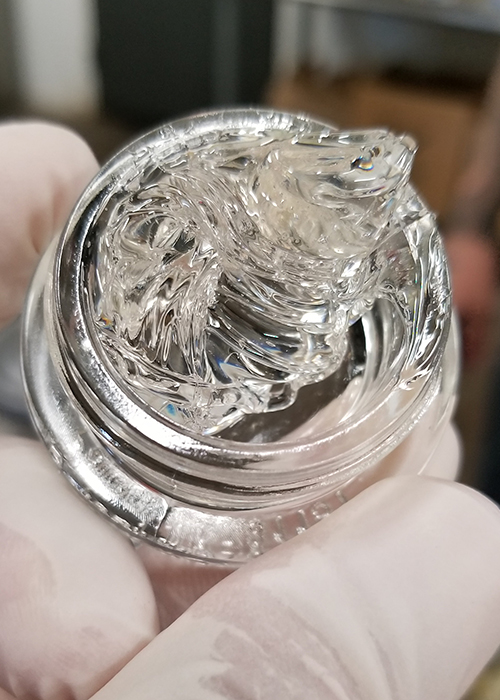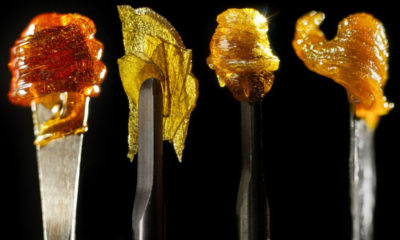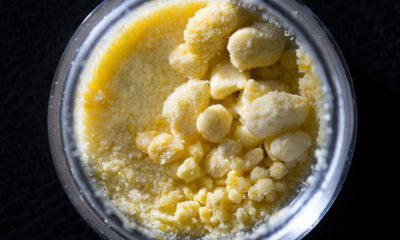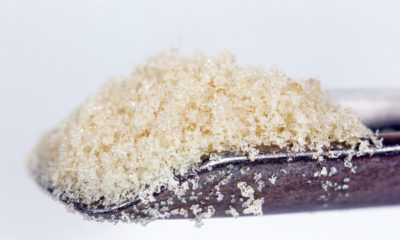
Concentrates
Atomic Bonds: The Increasing Relevance of Delta-8-THC
Separated from its cannabinoid cousin delta-9-THC by one chemical pathway, delta-8-THC is seeing more prominence due to increased attention on another well-known cannabinoid: CBD.
Nowadays, a compound called delta-8-tetra-hydrocannabinol (THC) is becoming increasingly common to find in concentrated extracts at dispensaries in states that allow for the medical or recreational sale of cannabis products. But from where did this long-lost sibling of delta-9-THC seemingly suddenly appear?
Quite simply, delta-8-THC has been hiding in plain sight (so to speak) for quite some time now. Our understanding of cannabinoids really began in 1964, when Dr. Raphael Mechoulam successfully identified delta-9-THC, a compound that quickly garnered fame and became known in common parlance simply as THC.
Mechoulam’s discovery loosened the main thread that finally allowed other scientists to untangle the dense and finely woven skeins of cannabis’ biochemical tapestry and therapeutic potential, soon realizing that cannabis is a complex plant with more than 60 identifiable cannabinoids that interact with a neurotransmitter system in the brain and body known as the endocannabinoid system.
Armed with this new knowledge, researchers identified delta-8-THC in the early 1970s. However, their discovery came with very little fanfare, given the compound’s low levels of natural occurrence and a potency seemingly lower than delta-9-THC. The researchers discovered that delta-8-THC had almost exactly the same atomic structure as delta-9-THC: The only difference was the placement of one atomic bond in the compound. Of course, this one small difference can mean the compound has different impacts on a user altogether.
So, what are the effects of delta-8-THC (here- after referred to as delta-8)? Subsequent to its discovery, some amount of research was done on delta-8 in the United States, including on its efficacy as an antiemetic (i.e. nausea inhibitor) and its potential to aid in arresting tumor growth. However, further exploration of the cannabinoid’s promise came to a standstill almost immediately and it was eventually consigned to some figurative, Reagan-era dusty shelf for over two decades.

Delta-8 extracted and processed by Oleum Labs in Washington state.
PHOTO Oleum Labs
Like so many cannabinoid-related events, delta-8’s reemergence from obscurity and current rise to prominence finds its roots, perhaps unsurprisingly, with Mechoulam. In 1995, his tenacious curiosity about cannabis’s therapeutic abilities had somehow led him back to delta-8 and his team in Israel conducted studies that reconfirmed the potential that American researchers had only begun to uncover. Using the substance’s lower psychoactivity to their advantage, the Israeli researchers discovered they could give high dosages of delta-8 to make the best use of its antiemetic effects without the uncomfortable aspects of the “high” brought on by delta-9.
Mechoulam and his research team almost certainly must have faced a quandary with the choice of delta-8 for their research: Given its low frequency of natural occurrence, how would they be able to source the material needed for therapeutic usage? The answer was found in a U.S. patent filed by Mechoulam and two other researchers much later in 2004. The patent is a recipe for converting the more commonly available cannabinoid CBD into delta-8 and delta-9.
The method is called isomerization, and it uses chemical processes to break the atomic bonds in one molecule (in this case, CBD) and, because it shares the same atoms, albeit in a different arrangement, transforms it into another molecule (delta-8 or delta-9). Indeed, the process of isomerizing cannabinoids was known to Mechoulam since the late 1960s. That process has also been known to the underground cannabis world nearly as long, though its actual utility was questionable at best (see Larry Todd’s 1974 book “Dr. Atomic’s Marijuana Multiplier,” from which any science-savvy extractors will almost certainly get a good laugh).
Current advances in technology have only made the method of isomerizing CBD into the two forms of THC easier in the last decade. Delta-8’s current appearance in the recreational cannabis marketplace is the result of the modern generation of innovative, science-based cannabis extraction artists. The sheer ubiquity of other scientific extraction methods like distillation — which gives us the key ingredient in nearly every vaporizer cartridge and most edibles available for sale — should offer some insight as to how prominently delta-8 may feature into the future of cannabis products (it’s worth noting that delta-8 is already available in distillate cartridges, among other forms). One factor that will almost certainly aid delta-8’s rise to prominence is the availability of the primary ingredient needed to make this converted THC: CBD.
Massive plots of high-CBD hemp (legally defined as any cannabis plant with less than 0.3 percent delta-9-THC) are currently being grown in several states and, when harvested, are spun down into pound upon pound of pure crystalline CBD extract, which can then be relatively easily converted into delta-8 or delta-9. The sheer volume of CBD crystallite being produced in the U.S. is currently unknown, but it is easy to suspect that the amount would be staggering if calculated. It is no stretch of the imagination to think that the proliferation of retail-ready, lab-assembled cannabinoids like delta-8 is at hand, if not already well underway.
Originally published in the print edition of Cannabis Now.


























